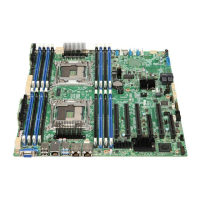Intel® Server Board S2600CW Platform Management Intel® Server Board S2600CW Family TPS
74 Revision 2.4
the SEL against the CATERR sensor and the default action after logging the SEL entry is to
reset the system. The BIOS setup utility provides an option to disable or enable system reset
by the BMC for detection of this condition.
The sensor is rearmed on power-on (AC or DC power-on transitions). It is not rearmed on
system resets in order to avoid multiple SEL events that could occur due to a potential reset
loop if the CATERR keeps recurring, which would be the case if the CATERR was due to an
MSID mismatch condition.
When the BMC detects that this aggregate CATERR signal has asserted, it can then go through
PECI to query each CPU to determine which one was the source of the error and write an OEM
code identifying the CPU slot into an event data byte in the SEL entry. If PECI is non-functional
(it isn’t guaranteed in this situation), then the OEM code should indicate that the source is
unknown.
Event data byte 2 and byte 3 for CATERR sensor SEL events
ED1 – 0xA1
ED2 – CATERR type
0: Unknown
1: CATERR
2: CPU Core Error (not supported on Intel® Server Systems supporting the Intel® Xeon®
processor E5-2600 v3 and v4 product families)
3: MSID Mismatch
ED3 – CPU bitmap that causes the system CATERR
[0]: CPU1
[1]: CPU2
[2]: CPU3
[3]: CPU4
5.3.11.5 MSID Mismatch Sensor
The BMC supports an MSID Mismatch sensor for monitoring for the fault condition that will
occur if there is a power rating incompatibility between a baseboard and a processor.
The sensor is rearmed on power-on (AC or DC power-on transitions).
5.3.12 Voltage Monitoring
The BMC provides voltage monitoring capability for voltage sources on the main board and
processors so that all major areas of the system are covered. This monitoring capability is
instantiated in the form of IPMI analog/threshold sensors.

